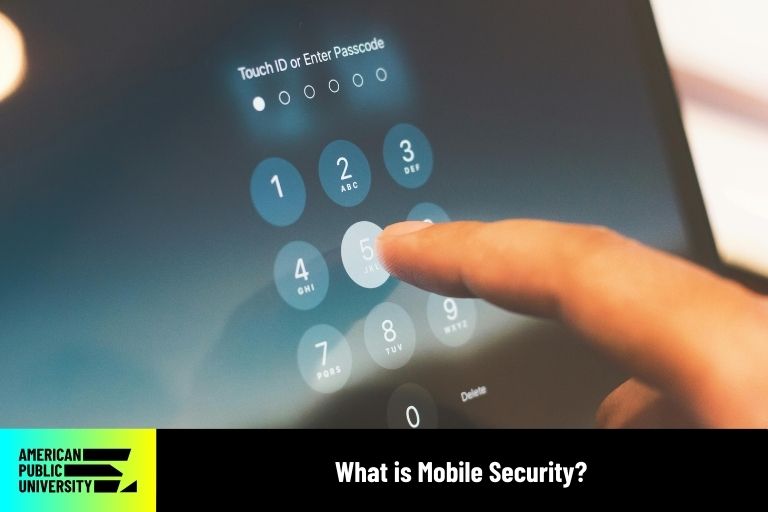09/29/2025

How to Secure Mobile Devices and Personal Data
In today’s digital age, smartphones and tablets aren't just communication tools—they’re mini-computers that store sensitive data, manage financial transactions, and connect to secure networks for work, school, and personal life. As our dependence on mobile devices grows, the risk of mobile security threats like malicious software, phishing attacks, and unauthorized access increases as well.
Mobile security refers to the practices, tools, and technologies designed to protect mobile devices and the private data stored on them. It involves preventing data breaches, securing mobile operating systems like iOS and Android, and minimizing risks that come from public networks, mobile apps, and even everyday text messages and email security vulnerabilities.
For those thinking about a career in cybersecurity or related fields, understanding mobile security is a valuable foundation for those interested in learning how organizations approach digital risk management.
Why Mobile Device Security Matters
Mobile device security is critical because these devices have become gateways to personal, academic, and professional information. No matter if you're accessing cloud service providers, responding to email security alerts, or logging into your bank account, smartphones are deeply connected to nearly every part of modern life.
Here’s why protecting mobile devices matters:
- Sensitive information at risk: From personal photos to stored passwords, mobile phones hold significant private data.
- Wider attack surface: With more mobile device users than ever, attackers see an opportunity to exploit security flaws and gain unauthorized access.
- Growth of mobile apps: While mobile apps make life easier, poorly secured apps can expose devices to mobile malware and data leaks.
Common Mobile Security Threats
1. Malicious Software and Mobile Malware
Malware—including viruses, spyware, and ransomware—can infiltrate your device through mobile apps, infected links, or unsafe downloads. Once installed, malicious software may steal stored data, track activity, or disrupt device functionality depending on the nature of the threat.
2. Unsecured Wi-Fi Networks
Public networks in coffee shops, airports, or libraries can expose your device to data breaches and unauthorized access. Attackers often intercept information like private data, email security credentials, or even text messages sent over unprotected connections.
3. Phishing Attacks
Phishing targets mobile device users through fake emails, text messages, or social media prompts designed to trick you into sharing sensitive information like passwords or bank details.
4. Outdated Operating Systems
Skipping security patches or delaying operating system updates leaves devices vulnerable to known exploits. For both Android devices and iPhones, staying updated is essential for strong mobile phone security.
Recommended Practices for Securing Mobile Devices
If you’re wondering how mobile security works, the good news is that many solutions are simple to adopt. Following best practices can significantly reduce exposure to threats:
- Enable two-factor authentication (2FA): Adds a layer of protection beyond just passwords.
- Use antivirus protection: Security software can detect and block mobile device attacks.
- Set strong passwords and biometrics: Combine complex passcodes with biometric authentication like fingerprint scanning.
- Be cautious with mobile apps: Only download apps from trusted sources and review permissions carefully.
- Use a virtual private network (VPN): A VPN encrypts your connection on public networks, helping protect against data leaks.
- Back up stored data: Regular backups can prevent permanent data loss in case of security breaches or device failures.
These steps aren’t just helpful for personal safety; they’re also foundational knowledge for those exploring cybersecurity careers.
The Role of Operating Systems in Mobile Security
Your mobile operating system—whether Android or iOS—plays a huge role in device security.
- Built-in protections: Modern operating systems include safeguards like secure network protocols, encrypted storage, and biometric authentication that all target threats to mobile.
- Security patches matter: Developers release security updates to fix vulnerabilities quickly; ignoring them can leave devices exposed.
- App-level permissions: Operating systems allow users to manage how apps access sensitive data, stored files, and network connections.
Understanding these features helps individuals manage mobile device security threats more effectively, whether protecting personal devices or designing solutions for organizations.
Mobile Device Security Solutions and Tools
Along with personal practices, organizations often implement broader mobile security solutions to protect employees and networks:
- Mobile device management (MDM): Centralizes control of devices, ensuring consistent security software, updates, and access permissions.
- Secure web gateways: Protect mobile devices from malicious websites and phishing attempts.
- Cloud access security brokers (CASBs): Help monitor and control access to cloud-based data and apps.
- Endpoint security: Combines device-level protections with network security measures for a complete approach.
Protecting Email and Data on Mobile Devices
Email security is a key aspect of mobile security.
Protect your accounts by:
- Using encrypted email services when possible
- Avoiding clicking unknown links or opening suspicious attachments
- Enabling two-factor authentication to prevent unauthorized access
- Staying connected to secure networks when sending sensitive information
As phishing attacks increasingly target mobile users, understanding these protections is needed for preventing data breaches and identity theft.
The Importance of Mobile Security
Mobile security isn’t just an IT concern; it’s an essential life skill. A basic understanding helps protect private data, safeguard devices, and support everyday digital literacy.
In fields like cybersecurity, IT, and data protection, understanding the mobile threat landscape also opens opportunities to work with security teams, build better mobile apps, and design secure coding practices that minimize vulnerabilities.
Building Your Knowledge in Mobile Security
Mobile device security impacts almost every aspect of modern life—from protecting sensitive data to understanding how malicious software spreads across mobile operating systems.
For those interested in cybersecurity or IT careers, gaining a deeper understanding of mobile security solutions builds practical skills and confidence in protecting devices while navigating the broader security landscape.
Explore "What Does Mobile Security Do?" to learn how specific protections and tools work together to keep devices and data safe.
